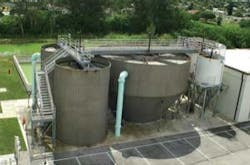At the Polar Beverages warehouse in Auburn, Mass., the engineers at Land Planning Inc. met with a space constraint issue.
Engineers designed a 112,500-square-foot addition to the existing 168,550-square-foot building, increasing the amount of impervious surfaces onsite. They also had to design a stormwater system that would infiltrate clean rooftop runoff back into the ground, recharging the groundwater. The amount of post-development runoff recharged back into the ground needed to be equal to or greater than the pre-development amount, as required by the local regulations.
While the engineers had enough space for capturing stormwater runoff from the parking lot and other ground-level surfaces in an above-ground detention system, the site had no area for an infiltration system. Thus, the engineers decided to use an underground infiltration chamber system.
"We needed a chamber that would have enough capacity to handle the runoff from a large rooftop area," said Norman G. Hill, project engineer and president of Land Planning Inc. "We could not use perforated pipes in this case because the pipes that could fit in the available space did not have enough storage capacity."
For the project, the engineers selected CULTEC's Recharger® V8™, the company's largest capacity plastic chamber able to hold a minimum of about 100 cubic feet of water. It is 32 inches high and 60 inches wide, with a bare chamber capacity of 8.68 cubic feet per linear foot. Located under the parking lot, the system captures rooftop runoff and slowly infiltrates it into the ground, replenishing the surrounding soil and aquifer.
The installation began with excavating a bed, laying filter fabric along the sides and the bottom and adding a layer of crushed stone. After the chambers were in place they were backfilled with stone, covered with a layer of fabric designed to reinforce the system to better bear traffic loads, and prepared for asphalt.
"The installation process took less than one week, which was very reasonable for such a large system," said Jeffrey Murray with Patriot Environmental Corp., the project contractor.
The stormwater runoff from the parking lot flows to a Stormceptor® unit for filtration and then the excess stormwater is sent into an extended detention wetland located beyond the parking lot. The system occupies 9,000 square feet of the 19.2-acre warehouse site, offering approximately 21,946 cubic feet of storage capacity.
WaterWorld Online, March 2011
###



